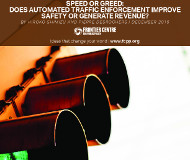Article from: www.thenewspaper.com/news/48/4850.asp
12/9/2015
Think Tank Report Examines Photo Ticketing Motivation
Frontier Centre for Public Policy evaluates the motivation behind the use of automated ticketing machines.
 Is photo enforcement for the money, or for safety? That is the question posed in a report released Tuesday by the Winnipeg, Canada-based think tank, the Frontier Centre for Public Policy. Researchers Hiroko Shimizu and Pierre Desrochers sought to place commonly cited traffic safety statistics in context to see whether the claims of photo enforcement advocates hold up to scrutiny.
Is photo enforcement for the money, or for safety? That is the question posed in a report released Tuesday by the Winnipeg, Canada-based think tank, the Frontier Centre for Public Policy. Researchers Hiroko Shimizu and Pierre Desrochers sought to place commonly cited traffic safety statistics in context to see whether the claims of photo enforcement advocates hold up to scrutiny.
Despite Canada's massive 560,000 mile road network and harsh winter climate, road fatalities declined 58 percent between 1970 and 2009. Traffic collisions now account for just 0.8 percent of all deaths in Canada.
"The fatality rate is now so low that almost twice as many Canadians die from falling accidents than traffic collisions," the report noted. "The average Canadian driver commuting 50 km per day would make 232 round trips to the moon before being expected to be involved in a fatal accident."
The report notes that the use of red light cameras and speed cameras to further reduce the accident rate has met with widespread opposition. Winnipeg's Wise Up Winnipeg and Vancouver's Safety by Education Not Speed Enforcement (SENSE) join the US-based National Motorists Association in arguing photo ticketing's primary motivation is revenue enhancement.
The report cites studies by the St. Louis Federal Reserve Bank (view study) and George Mason University (view study) which found that, in general, traffic tickets are issued in greater numbers whenever a municipality fell into financial difficulties. The remedy of issuing tickets with license points has little, if any, effect on behavior according to researchers from the University of Maryland School of Medicine (view study).
"In short, while increased fines and penalties are often justified in light of their alleged capacity to deter illegal driving behaviors and improve public safety, there simply isn't much evidence to back up this argument," the report found.
The report notes that violating the posted speed limit is just one factor in traffic accidents, and it is far from the most important one. Driver distraction consistently ranks far higher on the list of collision causes (view studies). Thus, rigorous photo enforcement studies have found limited, if any, benefit to the use of the cameras. The researchers suggest there are far better engineering alternatives to enhance safety.
"Much evidence suggests that automated traffic enforcement programs can at best play a very minor role or have limited and location-specific effects in terms of increasing road safety," the report found. "Many other proven measures are available, though, from revising speed limits to improving signage."
A copy of the report is available in a 1.3mb PDF file at the source link below.
Source: Speed or Greed: Does Automated Traffic Enforcement Improve Safety or Generate Revenue (Frontier Centre for Public Policy, 12/8/2015)
Permanent Link for this item
Return to Front Page
 Is photo enforcement for the money, or for safety? That is the question posed in a report released Tuesday by the Winnipeg, Canada-based think tank, the Frontier Centre for Public Policy. Researchers Hiroko Shimizu and Pierre Desrochers sought to place commonly cited traffic safety statistics in context to see whether the claims of photo enforcement advocates hold up to scrutiny.
Is photo enforcement for the money, or for safety? That is the question posed in a report released Tuesday by the Winnipeg, Canada-based think tank, the Frontier Centre for Public Policy. Researchers Hiroko Shimizu and Pierre Desrochers sought to place commonly cited traffic safety statistics in context to see whether the claims of photo enforcement advocates hold up to scrutiny.